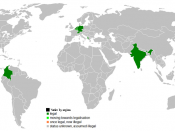Euthanasia and Assisted Suicide
Introduction
While medical life-ending behavior occurs in a great many jurisdictions, only very few have explicitly legalized euthanasia, physician-assisted suicide, or both. There are various forms of medical life-ending behavior that are classified as euthanasia. These include "active voluntary euthanasia," when medical intervention takes place, at a patient's request, to end the patient's life; "passive voluntary euthanasia," when medical treatment is withdrawn or withheld from a patient, at the patient's request, to end the patient's life; "active nonvoluntary euthanasia," when medical intervention takes place, without the patient's request, to end the patient's life; and "passive nonvoluntary euthanasia," when medical treatment or life support is withdrawn or withheld from a patient, without the patient's request, to end the patient's life.
In addition, there is physician-assisted suicide: suicide using a lethal substance prescribed, prepared, or given to a patient by a doctor for self-administration for assisting the patient to commit suicide.
Finally, the term double effect is reserved for the administration of drugs (usually large doses of opioids) with the intention of relieving pain, but foreseeing that this might hasten death, even though the hastening of death is not actually intended. The Australian Senate Legal and Constitutional Legislation Committee has used this definition.
Guidelines are usually in place to control medical conduct when it comes to double effect and passive nonvoluntary euthanasia (for instance in the case of severely brain-damaged newborns). Active euthanasia, to further a patient's request or not, usually remains a crime and often is classified as murder. The three jurisdictions with an exception to this rule are the state of Oregon in the United States and the neighboring European countries of the Netherlands and Belgium. There was a fourth jurisdiction, Australia's Northern Territory, but its Rights of the Terminally Ill Act 1995 was...


